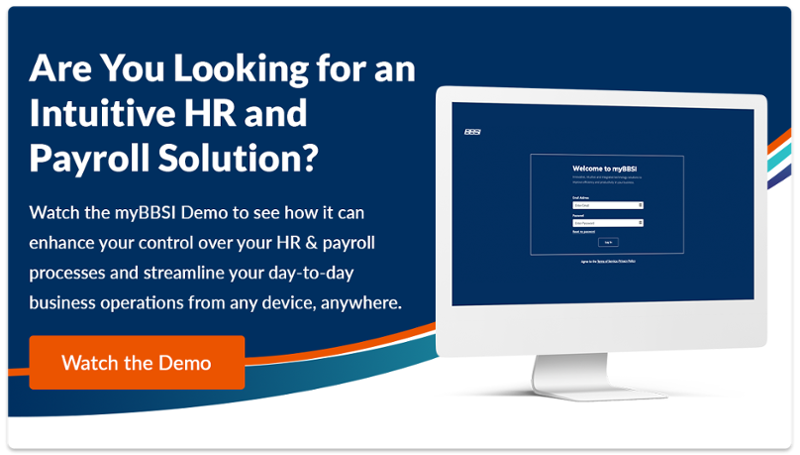
Everything Your Small Business Should Know About Payroll Management
Managing payroll is a complicated task that many small business owners have to handle on their own. Between navigating compliance and accuracy issues while balancing daily responsibilities, they often don’t have time to keep up with all the moving parts.
Every business's payroll is unique according to its employee classifications, pay structures, and relevant state and federal laws. However, employers can learn how payroll works by first understanding the factors that affect it and then understanding the different methods of payroll processing. With this knowledge, business owners can become equipped to do payroll for their business and select the best payroll system for their operation.
TABLE OF CONTENTS
What is Payroll?
Payroll is the compensation that a business needs to pay its employees for a set period of time or on a certain date. Usually, a company's accounting or human resources department manages it, though the owner or associate may manage payroll in smaller businesses.
The most common components of payroll are:
Depending on the industry, there may be more types of wages.
Is Payroll Management a Finance or HR Function?
It's difficult to classify payroll management as strictly either a finance or an HR function because it could be both. That's why business owners sometimes face a challenge in picking the right person to manage it.
Many businesses hire someone from a financial team because they generally need the person handling payroll to be well-versed in payroll figures. Someone with a finance background can understand these figures and use forecasting to make determinations.
Payroll could also be an HR function because it entails compliance and ensuring correct employee classifications, such as exempt or nonexempt, which a traditional accounting team member may not be familiar with.
At the end of the day, payroll management is likely a bit more of an HR function, but doing the best job requires a healthy balance of experience from both sides.
Factors that Contribute to Payroll Management
Employers determine payroll broadly according to each employee's pay structure and payment management system.
The pay structure includes the availability of overtime pay, payment schedule, method of tracking hours, and any incentives or benefits. It also considers factors that affect the employee's net pay, like state tax laws and benefits that might offer deductions.
But keeping payroll in compliance is much more complicated than these two broad components. Factors that also contribute to payroll management include:
- Benefits Deductions: These are wages that a business withholds from an employee’s total earnings. The deductions help pay garnishments, taxes, and benefits such as health insurance or retirement funds.
- Garnishments: A garnishment is a portion of a paycheck that gets legally withheld to send to another party. This is the way a third party can deduct payments directly from a bank account or a debtor's wage.
- Payroll Taxes: These are taxes companies pay on employee wages and salaries. The Federal Insurance Contributions Act states that the employer's federal payroll tax responsibilities include withholdings from an employee's compensation and paying their contribution for both Social Security and Medicare taxes.
- Compensation Structure and Types: Compensation structure entails pay grades that denote a job's value, both within the organization and in the external job market. The compensation types are different ways in which an employer can pay an employee for their labor (for instance, salary vs. hourly, overtime, sales commission, etc.).
- Time Tracking: This is the method an organization uses to record employees' working hours to ensure they have received accurate compensation for worked time. Tracking is one subcategory of time, alongside elements like attendance, time off, billable hours, and scheduling.
- Incentives and Bonuses: These are additional forms of compensation used to reward high performers and incentivize productivity. For payroll, managers need to establish how they will track incentives and bonuses, along with which state rules apply to them.
- State and Local Regulations: Employers have to pay their employees in compliance with relevant legislation, such as AB5, the gig worker bill in California. This includes minimum wage law, independent contractor classifications, paid rest periods, meal periods, etc.
- Employee Classification: The Fair Labor Standards Act permits certain types of employees to be exempt from their requirements. Employee classifications also determine the benefits they receive. Common classifications are full-time and part-time, but there are many more that offer varying compensation, duration, and work hours.
- Final Paycheck Procedure: Relevant local and state legislations outline the way to handle paying employees their final wages when they leave.
Critical Payroll Legislation Small Business Owners Should Understand
Many classification errors can occur during the payroll management process. Small business owners need to understand relevant legislation for the following aspects of payroll:
- Calculating Correct Rate of Pay: Most litigation, along with the largest fines and penalties, tends to come from incorrectly calculating an employee’s pay rate. This includes appropriate overtime calculations, especially in states like California that require weighted overtime calculations. Another common mistake involves meal break penalties — if an employee doesn't use their meal hour, they should receive an extra hour of pay.
- Final Pay and Terminations: In most states, when an employer lets someone go, they must pay the employee's final wages in a check, rather than a direct deposit. In other states, employers can make this final payment to any employee — or to some employees, with exceptions, according to the state's restrictions — on the next pay cycle. Small townships may also impose their own rules.
- Remote Work Tax Burdens: With the rise of remote work, companies are embracing remote work opportunities. Employers must be aware of taxation laws for employees across multiple states. As remote work increased, so did remote work misclassifications.
- State Unemployment Tax Act (SUTA) payments: Remote work is predicted to rise to 22% of the American workforce by 2025. With this in mind, employers must exercise diligence in accurately documenting where people live. Many employers don't realize they need to open a state unemployment account in states where their remote employees live, even if the business itself doesn't operate there.
- Minimum Wage Standards: Each state has its own standards for minimum wage and overtime calculations.
- Exempt versus nonexempt: To meet federal requirements, employers must correctly classify their employees based on specific standards that determine whether they are hourly or salaried. Misclassifying an hourly employee as a salaried employee can lead to penalties like damage to reputation, fines, and even prison time.
Different Ways Small Businesses Can Complete Payroll
With the technology available today, there are many ways small businesses can run their payroll. This gives employers the ability to pick the best option according to their specific situation.

In-house Payroll Expertise
Businesses could choose to let an internal department handle payroll processing. The staff who process payroll in-house are categorized as employees. As a result, employers pay them through the same payroll management system that they help manage.
This option is not ideal, however, as it's often more time-consuming for internal team members and owners. It also requires in-house expertise, which is a rare, and often expensive, skill set. The risk of compliance challenges can dissuade in-house payroll options if a business can’t hire someone with the necessary expertise.
Payroll Software
Small businesses with between one and 50 employees often use payroll software like QuickBooks to manage payroll in-house.
These programs are a cost-effective way to simplify the process of job costing, making estimates, paying vendors, and paying employees. The software can help ensure that employers correctly deliver employees' pay rates and accurately account for meal break penalties and overtime.
This method still leaves employers with complicated responsibilities, including filings with different states and filing annual W-2s.
Payroll management software may offer small businesses an affordable in-house option until the company grows beyond its capabilities and becomes more complex. As businesses grow, they should consider hiring third-party professionals to manage and scale their payroll.
Payroll Professional
Outsourcing payroll to a professional is a cost-effective and time-saving option that takes the burden off a business owner’s shoulders and places payroll into experienced hands they can trust.
Payroll service professionals can handle all payroll responsibilities, from collecting employee information and setting up direct deposits, to handling pay stubs and filing tax payments. Employers may also favor hiring a professional because they can expect to pay a fixed rate for the service, eliminating the need to hire a full-time employee.
Allowing a professional to take care of a business’s payroll can provide huge benefits to a company. It can also help support a more streamlined system of business operations.
What is a Payroll System?
Payroll systems manage everything related to the process of paying employees and filing employment taxes. Companies can implement them to track executable actions like:
- Worked hours
- Wage calculations
- Tax withholdings and other deductions
- Printing and delivering checks
- Paying government employment taxes
Small businesses, in particular, can greatly benefit from the features of payroll systems. For instance, employers can access tools to help them with:
- Time-tracking tool integration
- Simplified reporting, forecasting, and analysis
- Paperless record-keeping
- Direct employee access to stubs and forms, reducing admin time
- Streamlined employee onboarding with quick payroll form e-signing and e-filing
- More accurate job costing based on employee time tracking versus estimates
More sophisticated platforms, like myBBSI, offer an integrated system to help with additional functions, such as electronic employee onboarding and minimum wage and state tax compliance rules.
How to Determine the Best Payroll System for a Small Business
Each payroll system has certain selling points, and it can be confusing to determine the best payroll system for your business. To help sift through all the options, here are some key factors to consider.
- Features and Functionality: Businesses will favor certain features more depending on the industry. For example, many blue-collar employers prefer systems that offer more flexibility for job costing, because it helps them determine more accurate estimates and price jobs accordingly.
- Cost Structure: Some systems may charge according to pay frequency, while others charge per month or set fixed prices, especially if they offer do-it-yourself online solutions.
- Third-Party Integrations: Different systems have different third-party integrations that can offer benefits like secure data access, quicker payroll program deployment, and faster onboarding.
- Self-Service Access for Employees: Giving employees access to self-service options enables them to regularly review their own records and follow up when necessary to save employers time.
- Managing Employee Time Off: A good payroll system can track different types of leave and the balances employees have remaining.
- Reporting New Hires to the Government: State agencies require employers to report new hires shortly after the date of hire. Payroll systems can do this automatically when a new employee is entered into the database.
- Job Costing and Analysis: Sophisticated payroll systems track direct and indirect costs of individual projects and jobs, providing employers with analysis that helps them improve the accuracy of future estimates.
- Customer Service: A system with talented customer service representatives can save employers significant time researching and troubleshooting payroll challenges.
How to Set up and Manage Payroll for Small Businesses
Small and mid-size businesses can have a challenging time navigating payroll. The process of setting up and running payroll includes many critical steps to ensuring compliance and accuracy. Let’s look at four steps that will help you run your payroll smoothly.
1. Collect Accurate Employee Payroll Forms and Information
Since the necessary forms for compliance vary across states, employers need to make sure all employee information and payroll forms are accurate. This helps avoid complications from transferring incorrect information into their system, such as using an employee's preferred name instead of their legal name.
Employers need to collect critical employee application information, including:
- Accurate legal name
- Social Security number
- IRS W-4
- State W-4
- USCIS Form I-9
- Direct deposit authorization (optional)
- Company-sponsored benefits and proper elections
It's also important to establish the guidelines for employees' paid time off (PTO) plans, such as the number of sick days and vacation days employees receive. This helps employers ensure they're tracking and accruing hours correctly according to plan details. Employers should also verify the employee handbook accurately reflects the guidelines, so there isn't any confusion.

2. Choose Payroll Schedule
At this stage, employers must consider how the payroll schedule impacts their cash flow. For example, if a restaurant is busiest over the weekend, they probably shouldn’t pay their employees weekly on Fridays when they’re less likely to have the cash flow to cover payroll. Other factors employers should consider before establishing a payroll schedule include:
- Payment schedules for external vendors
- Employee details, such as the number of employees and their work schedules
- Processing and administrative costs
After accounting for these factors, employers can decide on a schedule that makes the most sense. The most common payment schedules are:
- Monthly
- Semi-monthly
- Bi-weekly
- Weekly
3. Calculate Payroll Withholdings
Employers take withholdings, such as garnishments and taxes, out of employees' paychecks to pay their income taxes per pay period or any debts they’re contributing towards. Typically, the payroll system will calculate this data on its own, though small business owners running their own payroll often must do it themselves.
For instance, they may encounter difficulties when handling garnishments less than or more than the state minimum wage. If employees have multiple garnishments, various state and federal guidelines prioritize them differently.
Another common mistake employers may make is paying an employee as a subcontractor if the IRS has informed the employer that the worker has a large garnishment. This practice should be avoided, as it places severe financial risks on both the employee and the employer.
4. Issue Employee Pay and File Correct Forms for Taxes and Reconciliations
Finally, employers must issue the employees' net pay via a live check or direct deposit. After this, businesses must complete their state and federal tax payments. Employers should review quarterly and annual reconciliations with the state, Fed, and IRS to ensure they file the right form. For instance:
- The IRS requires employers to annually report each employee's wages and taxes to the Social Security Administration on their Form W-2.
- Employers must report quarterly income taxes, Social Security tax, or Medicare withheld from employees' paychecks on Form 941, the Employer's Quarterly Federal Tax Return form.
Employers can reconcile these forms with payroll to verify the accuracy of the filings.
How to Migrate Data to a New Payroll Provider
Most software, including QuickBooks, have an employee export file that includes all employee data, such as:
- Name
- Date of birth
- Social Security number
- Pay rate
- Wages they have earned
Employers can import these files into their new provider's program, using metadata to place the information in its appropriate location.
Generally, there are no legal requirements for moving payroll. However, employers should be careful about letting different software providers know they're moving systems, because providers may choose to block access to the data.
In this case, or if the old provider cannot provide the data for whatever reason, employers can enter the information manually by using a PDF check report or employee applications. This method is time-consuming and should be a last resort option.
How BBSI Helps Small Businesses with Payroll
BBSI provides dedicated Payroll Consultants who familiarize themselves with a business’ processes to help spot trends, call out potential issues, and ensure payroll complies with state and federal legislation.
When a company partners with BBSI, they also get access to BBSI’s proprietary payroll portal, myBBSI, which has been designed with clients in mind. Business owners can utilize myBBSI to manage their payroll and onboard new employees from their phones or desktop. With quarterly and monthly system updates that add new features, its functionality continues to expand.
Finally, BBSI's pay-as-you-go workers’ compensation model and annualized billing eliminate payroll audits and offer businesses predictable monthly billing. This ensures that clients maintain their cash flow and don't receive an exorbitant bill at the end of the year due to misclassified employees or incorrectly reported wages. This gives employers a clearer idea of their monthly spend, helping them make projections and bid for projects more effectively.
Disclaimer: The contents of this white-paper/blog have been prepared for educational and information purposes only. Reference to any specific product, service, or company does not constitute or imply its endorsement, recommendation, or favoring by BBSI. This white-paper/blog may include links to external websites which are owned and operated by third parties with no affiliation to BBSI. BBSI does not endorse the content or operators of any linked websites, and does not guarantee the accuracy of information on external websites, nor is it responsible for reliance on such information. The content of this white-paper/blog does not provide legal advice or legal opinions on any specific matters. Transmission of this information is not intended to create, and receipt does not constitute, a lawyer-client relationship between BBSI, the author(s), or the publishers and you. You should not act or refrain from acting on any legal matter based on the content without seeking professional counsel.
